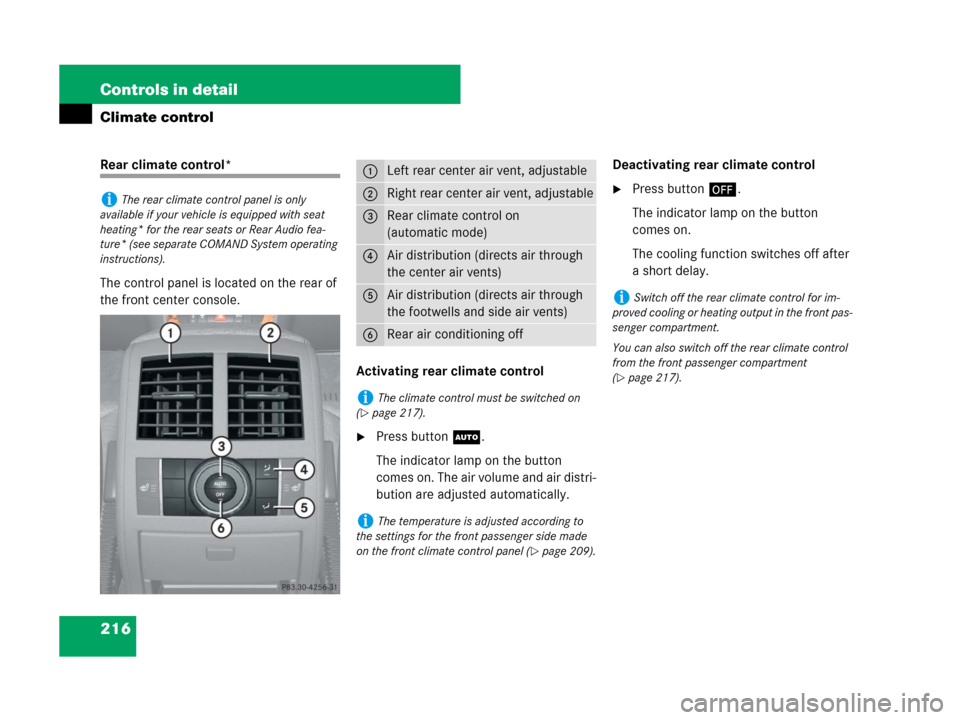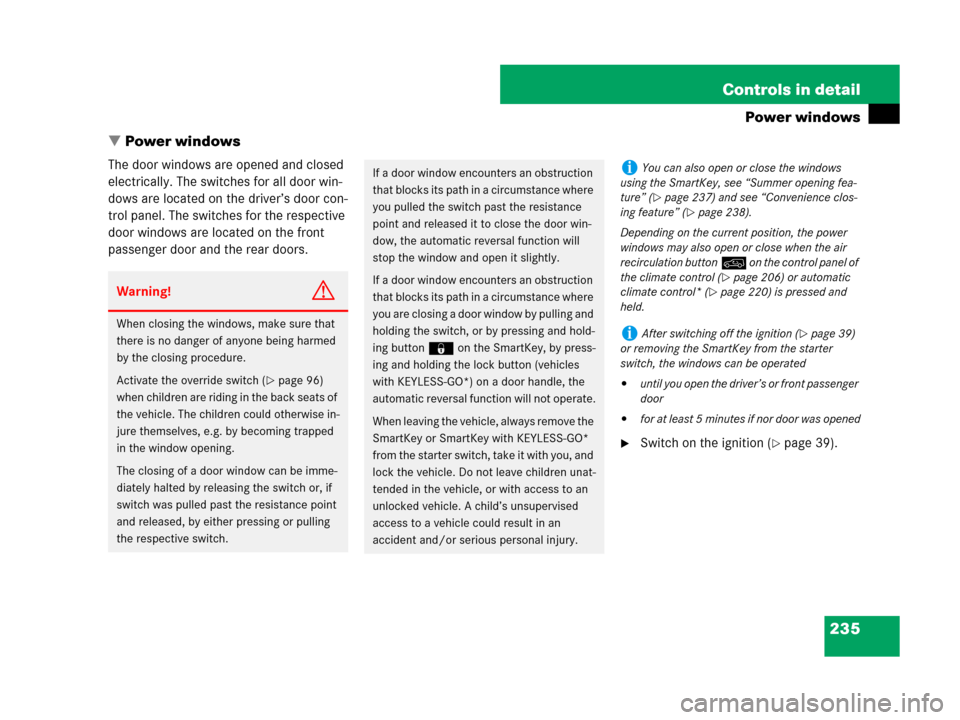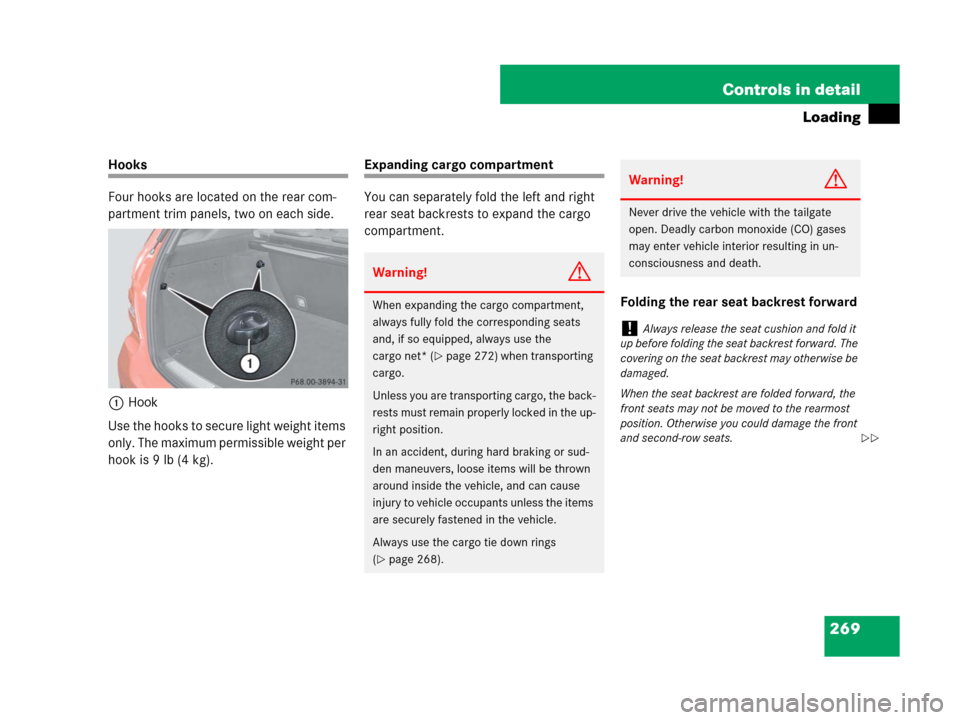Page 132 of 561

131 Controls in detail
Seats
The red indicator lamps in the switch come
on to show which heating level you have
selected.�Switch on the ignition (�page 40).
Switching on
�Press switch1.
Three red indicator lamps2 in the
switch come on.
�Continue pressing switch1 until
desired seat heating level is reached.
Switching off
�Press switch1 repeatedly until all
indicator lamps2 go out.
Seat ventilation*
The switches for the seat ventilation are
located in the center console.
1Seat ventilation switch, front seats
2Indicator lamps
Level
3Three indicator lamps on
(highest level)
The seat heating automatically
switches to level 2 after approx-
imately 5 minutes.
2Two indicator lamps on
The seat heating automatically
switches to level 1 after approx-
imately 10 minutes.
1One indicator lamp on
(lowest level)
The seat heating automatically
switches off after approximately
20 minutes.
offNo indicator lamp on
iIf one or more of the indicator lamps2 on
seat heating switch1 (
�page 130) are flash-
ing, there is insufficient voltage available since
too many electrical consumers are switched on.
The seat heating switches off automatically.
The seat heating will switch back on again
automatically as soon as sufficient voltage is
available.
Page 133 of 561
132 Controls in detail
Seats
The blue indicator lamps in the switch
come on to show which ventilation level
you have selected.
�Switch on the ignition (�page 40).Switching on
�Press button1 repeatedly until the
desired ventilation level is set.
Switching off
�Press button1 repeatedly until all
indicator lamps2 go out.
Level
3Three indicator lamps on
(highest level)
2Two indicator lamps on
1One indicator lamp on
(lowest level)
offNo indicator lamp on
iThe seat ventilation for the driver’s seat is
automatically set to the highest level if activated
via summer opening feature (
�page 237).
Page 135 of 561
134 Controls in detail
Memory function*
Storing positions into memory
�Adjust the seats (�page 43).
�On the driver’s side, additionally adjust
the steering wheel (
�page 48) and ex-
terior rear view mirrors (
�page 49) to
the desired positions.
�Press memory buttonM.
�Release memory buttonM and press
stored position button1,2 or3 within
3 seconds.
All settings are stored to the selected
position.
Recalling positions from memory
�Press and hold stored position
button1,2 or3 until the seat, steering
wheel and exterior rear view mirrors
have fully moved to the stored posi-
tions.
!Do not operate the power seats using
memory buttonM if the seat backrest is in an
excessively reclined position. Doing so could
cause damage to front or rear seats.
Move seat backrest to an upright position first.
iReleasing the stored position button stops
movement to the stored positions immediately.
Page 217 of 561

216 Controls in detail
Climate control
Rear climate control*
The control panel is located on the rear of
the front center console.
Activating rear climate control
�Press buttonU.
The indicator lamp on the button
comes on. The air volume and air distri-
bution are adjusted automatically.Deactivating rear climate control
�Press button´.
The indicator lamp on the button
comes on.
The cooling function switches off after
a short delay.iThe rear climate control panel is only
available if your vehicle is equipped with seat
heating* for the rear seats or Rear Audio fea-
ture* (see separate COMAND System operating
instructions).
1Left rear center air vent, adjustable
2Right rear center air vent, adjustable
3Rear climate control on
(automatic mode)
4Air distribution (directs air through
the center air vents)
5Air distribution (directs air through
the footwells and side air vents)
6Rear air conditioning off
iThe climate control must be switched on
(
�page 217).
iThe temperature is adjusted according to
the settings for the front passenger side made
on the front climate control panel (
�page 209).
iSwitch off the rear climate control for im-
proved cooling or heating output in the front pas-
senger compartment.
You can also switch off the rear climate control
from the front passenger compartment
(
�page 217).
Page 236 of 561

235 Controls in detail
Power windows
�Power windows
The door windows are opened and closed
electrically. The switches for all door win-
dows are located on the driver’s door con-
trol panel. The switches for the respective
door windows are located on the front
passenger door and the rear doors.
�Switch on the ignition (�page 39).
Warning!G
When closing the windows, make sure that
there is no danger of anyone being harmed
by the closing procedure.
Activate the override switch (
�page 96)
when children are riding in the back seats of
the vehicle. The children could otherwise in-
jure themselves, e.g. by becoming trapped
in the window opening.
The closing of a door window can be imme-
diately halted by releasing the switch or, if
switch was pulled past the resistance point
and released, by either pressing or pulling
the respective switch.
If a door window encounters an obstruction
that blocks its path in a circumstance where
you pulled the switch past the resistance
point and released it to close the door win-
dow, the automatic reversal function will
stop the window and open it slightly.
If a door window encounters an obstruction
that blocks its path in a circumstance where
you are closing a door window by pulling and
holding the switch, or by pressing and hold-
ing button‹on the SmartKey, by press-
ing and holding the lock button (vehicles
with KEYLESS-GO*) on a door handle, the
automatic reversal function will not operate.
When leaving the vehicle, always remove the
SmartKey or SmartKey with KEYLESS-GO*
from the starter switch, take it with you, and
lock the vehicle. Do not leave children unat-
tended in the vehicle, or with access to an
unlocked vehicle. A child’s unsupervised
access to a vehicle could result in an
accident and/or serious personal injury.iYou can also open or close the windows
using the SmartKey, see “Summer opening fea-
ture” (
�page 237) and see “Convenience clos-
ing feature” (
�page 238).
Depending on the current position, the power
windows may also open or close when the air
recirculation button: on the control panel of
the climate control (
�page 206) or automatic
climate control* (
�page 220) is pressed and
held.
iAfter switching off the ignition (�page 39)
or removing the SmartKey from the starter
switch, the windows can be operated
�until you open the driver’s or front passenger
door
�for at least 5 minutes if nor door was opened
Page 268 of 561

267 Controls in detail
Loading
Load distribution
The gross vehicle weight which is the
weight of the vehicle including fuel, tools,
spare wheel, installed accessories, pas-
sengers and luggage/cargo must never
exceed the load limit and Gross Vehicle
Weight Rating (GVWR) for your vehicle as
specified on the placard located on the
driver’s door B-pillar (
�page 510). In addi-
tion, the load must be distributed in such a
way so that the weight on each axle never
exceeds the Gross Axle Weight Rating
(GAWR) for the front and rear axle. The
GVWR and GAWR for your vehicle are indi-cated on the certification label which can
be found on the driver’s door B-pillar
(
�page 510).
For more information, see “Tire and Load-
ing Information” (
�page 352).
The handling characteristics of a fully load-
ed vehicle depend greatly on the load dis-
tribution. It is therefore recommended to
load the vehicle according to the illustra-
tions shown, with the heaviest items being
placed towards the front of the vehicle.
Please pay attention to and comply with
the following instructions when loading the
vehicle and transporting cargo:
�Always place items being carried
against front or rear seat backrests,
and fasten them as securely as possi-
ble.
�The heaviest portion of the cargo
should always be kept as low as possi-
ble against front or rear seat backrests.For additional safety when transporting
cargo while the rear seats are unoccupied,
fasten the outer seat belts crosswise into
the opposite side buckles.
iThe cargo compartment is the preferred
place to carry objects. The expanded cargo com-
partment (
�page 269) should only be used for
items which do not fit in the cargo compartment
alone.
Page 269 of 561
268 Controls in detail
Loading
Cargo tie-down rings
Your vehicle is equipped with six cargo
tie-down rings.
Carefully secure cargo by applying even
load on all rings with rope of sufficient
strength to hold down the cargo.Cargo compartment
Four cargo tie-down rings are located in
the cargo compartment.
1Cargo tie-down ringBehind front seats
Two cargo tie-down rings are located in the
footwell behind the driver’s and passenger
seat.
1Cargo tie-down ring
iWhile the cargo net* (�page 272) will help
protect you from smaller objects, it cannot pre-
vent the movement of large, heavier objects into
the passenger compartment in an accident, dur-
ing hard braking or sudden maneuvers. Such
items must be properly secured using the cargo
tie-down rings in the cargo compartment floor.
Page 270 of 561

269 Controls in detail
Loading
Hooks
Four hooks are located on the rear com-
partment trim panels, two on each side.
1Hook
Use the hooks to secure light weight items
only. The maximum permissible weight per
hook is 9lb(4kg).Expanding cargo compartment
You can separately fold the left and right
rear seat backrests to expand the cargo
compartment.
Folding the rear seat backrest forward
Warning!G
When expanding the cargo compartment,
always fully fold the corresponding seats
and, if so equipped, always use the
cargo net* (
�page 272) when transporting
cargo.
Unless you are transporting cargo, the back-
rests must remain properly locked in the up-
right position.
In an accident, during hard braking or sud-
den maneuvers, loose items will be thrown
around inside the vehicle, and can cause
injury to vehicle occupants unless the items
are securely fastened in the vehicle.
Always use the cargo tie down rings
(
�page 268).
Warning!G
Never drive the vehicle with the tailgate
open. Deadly carbon monoxide (CO) gases
may enter vehicle interior resulting in un-
consciousness and death.
!Always release the seat cushion and fold it
up before folding the seat backrest forward. The
covering on the seat backrest may otherwise be
damaged.
When the seat backrest are folded forward, the
front seats may not be moved to the rearmost
position. Otherwise you could damage the front
and second-row seats.
��